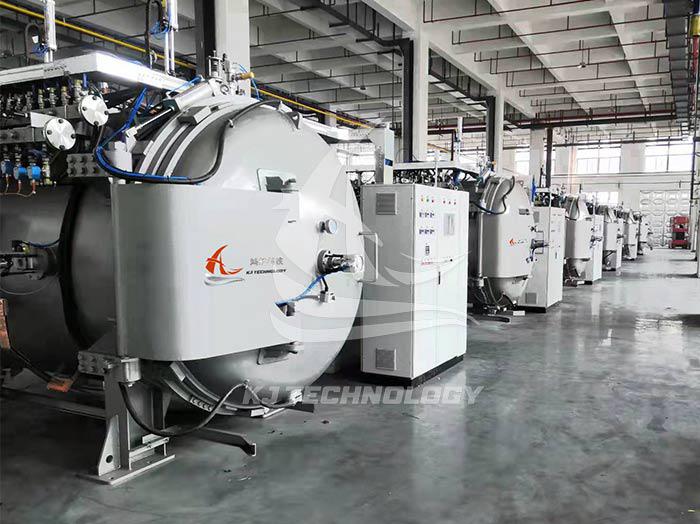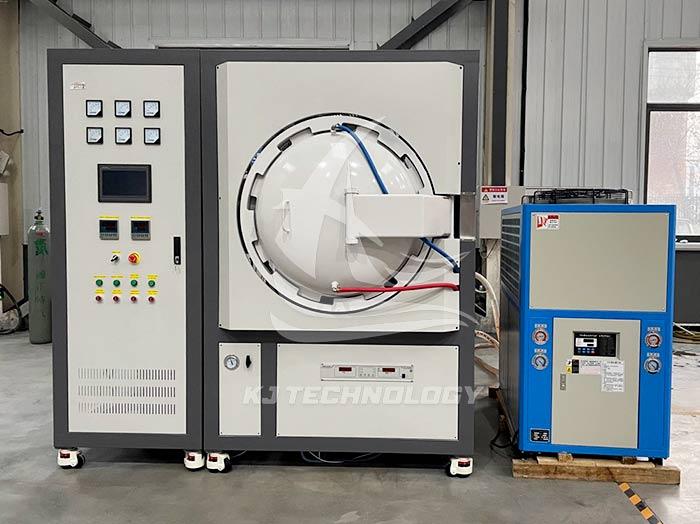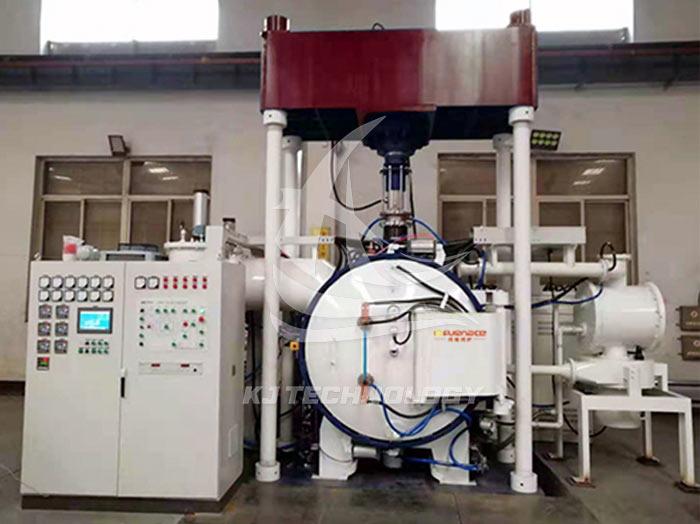Application of Electric Heating Vacuum Heat Treatment Furnace in the Battery Industry
 08-14-2025 Author: KJ technology
08-14-2025 Author: KJ technology
The application of electric heating vacuum heat treatment furnace in the battery industry is extensive and critical, running through multiple core links of battery manufacturing. Its core role is reflected in three aspects: improving material performance, ensuring battery safety, and optimizing manufacturing processes. The specific application scenarios and technical advantages are as follows:
1. Core application scenarios
Preparation and Modification of Electrode Materials
Sintering of positive electrode materials: In the sintering process of lithium battery positive electrode materials (such as NCM811, LiCoO ₂), the vacuum environment can accurately control the oxygen partial pressure (10-100Pa) to avoid material oxidation or decarburization. At the same time, uniform doping is achieved through gradient temperature control (such as preheating section 500 ℃ → reaction section 900 ℃ → cooling section 200 ℃), significantly improving the battery cycle life (exceeding 2000 times) and capacity retention rate (up to 98%).
Negative electrode material treatment: In the manufacturing of nickel hydrogen battery negative plates, vacuum sintering (900 ℃, vacuum degree 2 × 10 ⁴ Pa) can eliminate internal defects of the plates, improve flexibility and specific energy (from 220mAh/g to 250mAh/g), and extend the battery's service life (from 200 times to over 300 times).
Battery packaging and sealing guarantee
Vacuum injection: By using a circuitous vacuum (vacuum degree 5 × 10 ³ Pa~10 ⁴ Pa) to remove the air inside the battery, ensure that the electrolyte fully infiltrates the electrode material, reduce residual bubbles, and improve the electrochemical performance and safety of the battery. For example, the moisture content of bare cells in lithium batteries can be reduced from 500~2000mg/kg to below 150mg/kg after injection.
Vacuum packaging: During the sealing process of battery chips and cover plates, a vacuum environment can prevent moisture and gases from entering the interior of the battery, improve sealing airtightness, eliminate leakage hazards, and ensure long-term stable operation of the battery.
Retired battery recycling and resource regeneration
Vacuum pyrolysis: In the recycling of waste zinc manganese batteries, vacuum pyrolysis technology (500-1100 ℃) can efficiently separate electrode materials from separators, achieving high-purity recovery of metals such as mercury (recovery rate 98.92%) and zinc (recovery rate 91.20%), while reducing pollutant emissions (reducing wastewater emissions by 90% compared to wet metallurgical processes).
Vacuum metallurgy: By heating to over 3000 ℃ with an electron beam and using a water-cooled copper crucible to avoid contamination, the C and O content in titanium alloys can be reduced to below 10ppm, meeting the dual requirements of lightweight and high-strength materials for spacecraft.
2. Analysis of Technical Advantages
Non oxidizing and non polluting environment
A vacuum environment can reduce the impurity partial pressure to below 10 ⁻⁵ Pa, which is equivalent to exposing the material to an "ultra clean room" environment, avoiding oxidation, decarburization, or impurity infiltration, significantly improving material purity. For example, in the preparation of proton exchange membrane fuel cell (PEMFC) catalysts, the vacuum reduction process can reduce Pt precursor to 2-5 nm nanoparticles with a standard deviation of particle size distribution<0.5 nm, and the catalytic activity is increased by 18% compared to traditional processes.
Accurate temperature and atmosphere control
Temperature control: S-type thermocouple and PID self-tuning algorithm are used to control temperature fluctuations within ± 1 ℃. Combined with the gradient insulation design of the alumina fiber furnace, the temperature difference within the 1400 ℃ high temperature field is ≤ 3 ℃, avoiding material cracking caused by temperature gradients.
Atmosphere control: Through a multi-channel gas mass flow controller (MFC), inert or reducing gases such as nitrogen, argon, and hydrogen can be accurately introduced, and the gas partial pressure inside the furnace can be monitored in real time. For example, in the preparation of graphene powder, by controlling the ratio of H ₂/N ₂ mixed atmosphere (volume ratio 1:9) and synergistic effect with high temperature of 1000 ℃, single-layer graphene with purity>99.5% can be prepared.
Energy conservation, environmental protection, and efficient production
Energy saving design: The thermal conductivity of the alumina fiber furnace is only 0.035W/(m · K), which is 60% -80% more energy-efficient than traditional refractory bricks; The double-layer water-cooled shell design ensures that the surface temperature of the furnace body is ≤ 60 ℃, avoiding the risk of operator burns.
Efficient production: The equipment supports 12 process modes including vacuum annealing, atmosphere sintering, CVD coating, etc., and can preset multiple temperature curves, significantly improving production efficiency. For example, a new energy battery company has increased its annual production capacity by 30% by precisely controlling the sintering process of LiCoO ₂ cathode material.
3. Industry application cases
Lithium battery manufacturing: The HM series vacuum atmosphere furnace of Shandong Hengmei Electronic Technology Co., Ltd. adopts imported lightweight alumina ceramic fiber furnace (with insulation performance better than 20% of industry standards), combined with a 7-inch touch screen supporting 16 stage program temperature control. It has been successfully applied to the sintering of lithium battery positive electrode materials in enterprises such as Ningde Times, with a product capacity retention rate increased to 98% and a cycle life exceeding 2000 times.
Fuel cell production: In the manufacturing of Toyota Mirai fuel cell stacks, vacuum brazing technology (vacuum degree 10 ⁻ ³ Pa, temperature 300-600 ℃) is used to connect bipolar plates and membrane electrodes, with a weld defect rate of<0.1%, meeting the requirements of hydrogen fuel cells for stable high-frequency signal transmission.
Retired battery recycling: Greenmei Company adopts vacuum pyrolysis technology to achieve a recovery rate of over 95% for cobalt, nickel, and lithium in waste power batteries, reducing wastewater emissions by 90% compared to wet metallurgical processes and promoting the closed-loop development of the battery industry.








